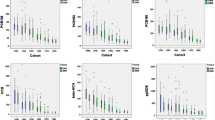Abstract
Objectives. To evaluate background exposure levels and determinants of the individual variations in the exposure to dioxins in Japan.
Methods. A cross-sectional study was performed on 131 men and 122 women (aged 20–76 years), who resided in five prefectures of Japan and had no occupational exposure to dioxins. Seven polychlorinated dibenzo-p-dioxins (PCDDs), ten polychlorinated dibenzo-furans (PCDFs) and 12 polychlorinated biphenyls (PCBs), which are assigned a toxicity equivalent factor, were determined in fasting blood. Biochemical analysis of plasma and a questionnaire survey on life-style, including dietary habit, were also performed. Factors associated with the levels of dioxin-related compounds in blood were evaluated by multiple linear regression.
Results. The median of total toxicity equivalents (TEQs) in men and women was 17 and 16 pg TEQ/g lipid, respectively, with no gender difference. After adjustment for age and other covariates, plasma concentrations of eicosapentaenoic acid, a biomarker of fish intake, were found to be positively associated with blood levels of total dioxin, PCDDs, PCDFs and PCBs, all of which were expressed on a TEQ basis (P<0.01). The frequency of intake of coastal fish, such as horse mackerel, mackerel and sardine, was also associated with TEQ-based concentrations of PCDFs (P=0.03) and PCBs (P=0.08). The intake of raw fish was positively related to total dioxins (P=0.06) and PCBs (P=0.03).
Conclusions. The level of intake of marine fish, especially raw fish and coastal varieties, may be associated with increased blood levels of dioxin-related compounds among the population. Despite high fish consumption in Japan, the body burden of dioxins in the population was not found to be higher than that in western countries.
Similar content being viewed by others
Author information
Authors and Affiliations
Additional information
Electronic Publication
Rights and permissions
About this article
Cite this article
Arisawa, K., Matsumura, T., Tohyama, C. et al. Fish intake, plasma ω-3 polyunsaturated fatty acids, and polychlorinated dibenzo-p-dioxins/polychlorinated dibenzo-furans and co-planar polychlorinated biphenyls in the blood of the Japanese population. Int Arch Occup Environ Health 76, 205–215 (2003). https://doi.org/10.1007/s00420-002-0400-y
Received:
Accepted:
Issue Date:
DOI: https://doi.org/10.1007/s00420-002-0400-y




